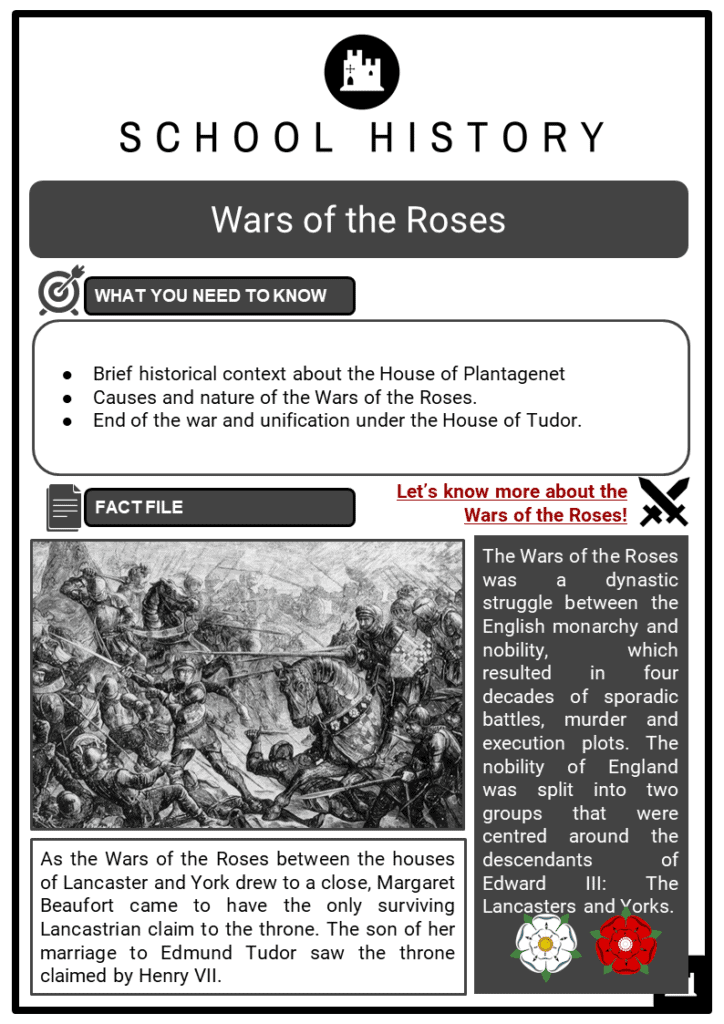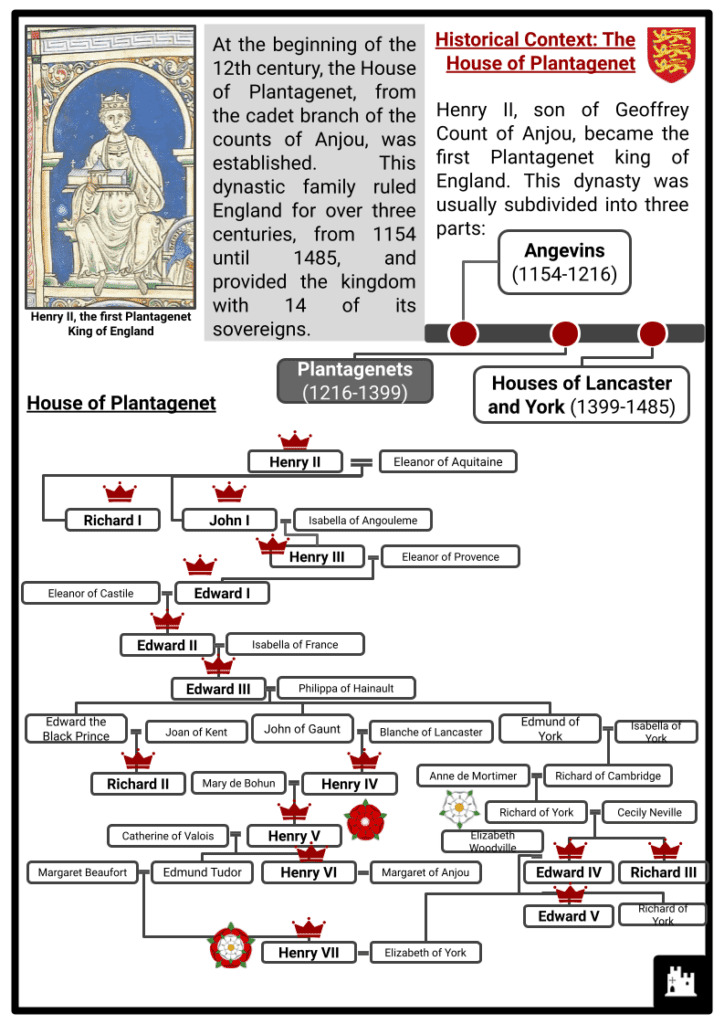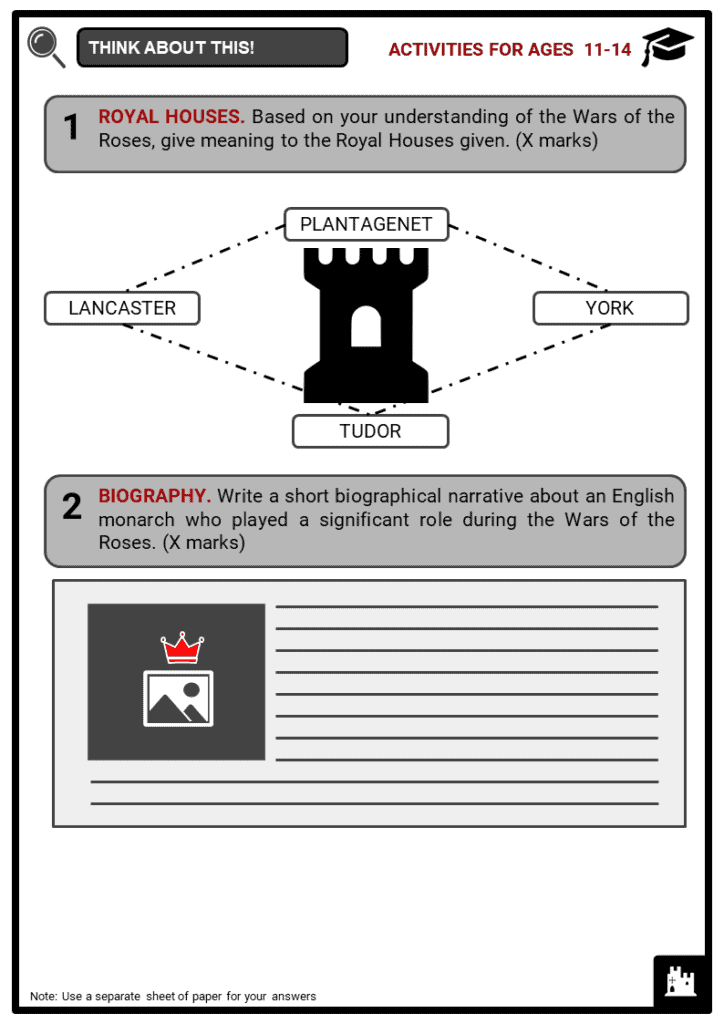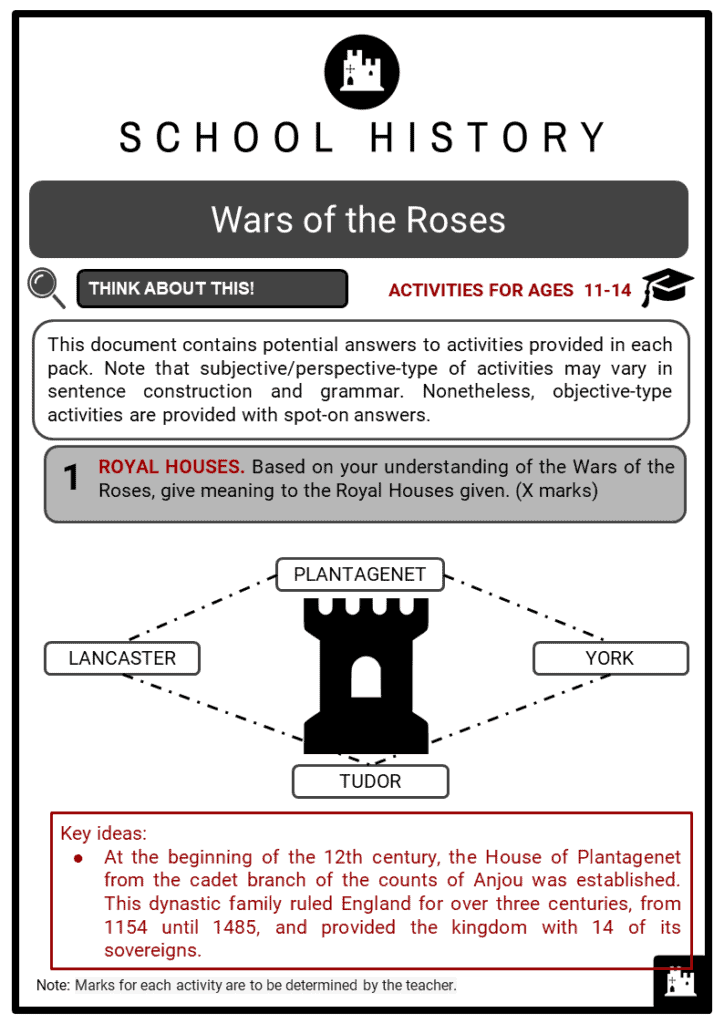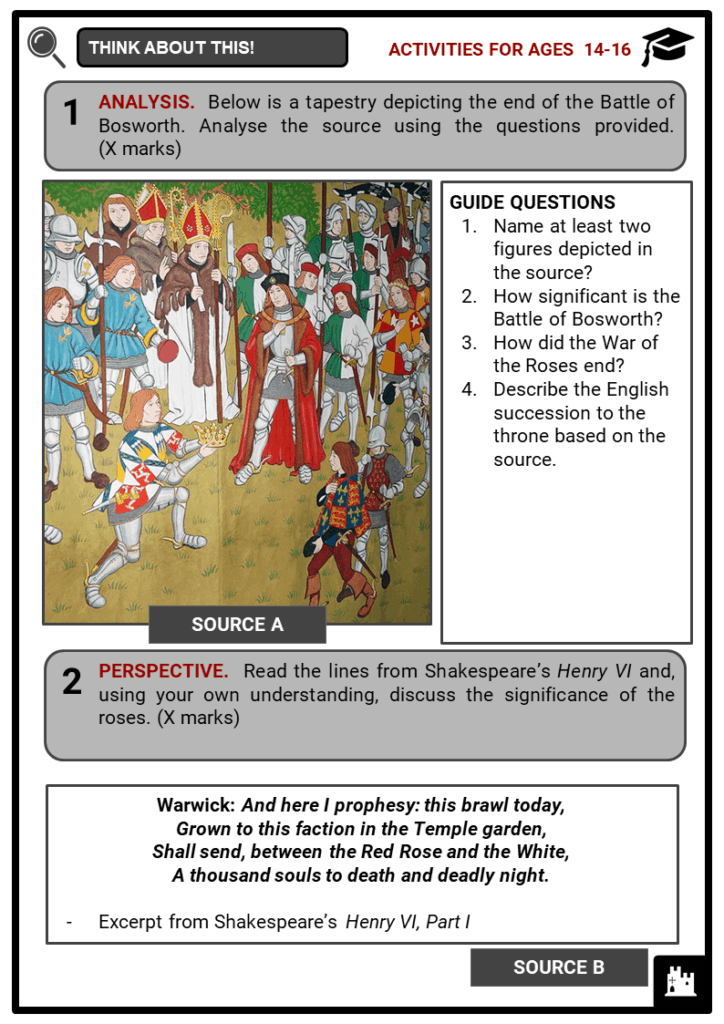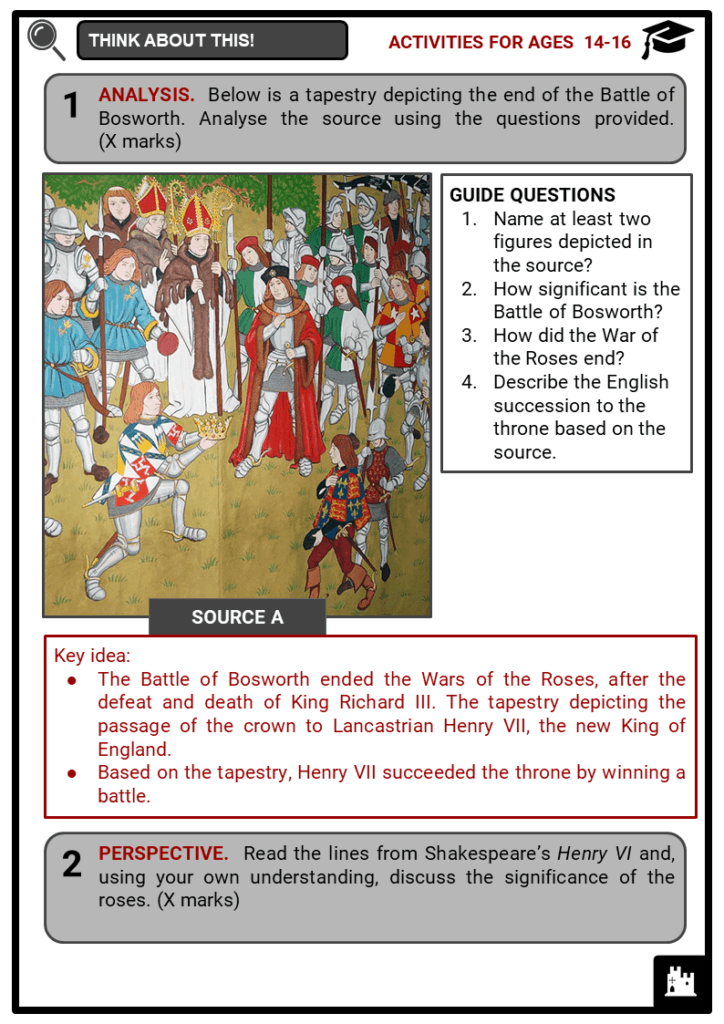Download Wars of the Roses Worksheets
Do you want to save dozens of hours in time? Get your evenings and weekends back? Be able to teach Wars of the Roses to your students?
Our worksheet bundle includes a fact file and printable worksheets and student activities. Perfect for both the classroom and homeschooling!
Table of Contents
Add a header to begin generating the table of contents
Summary
- Brief historical context about the House of Plantagenet
- Causes and nature of the Wars of the Roses.
- End of the war and unification under the House of Tudor.
Key Facts And Information
Let’s know more about the Wars of the Roses!
- The Wars of the Roses was a dynastic struggle between the English monarchy and nobility, which resulted in four decades of sporadic battles, murder and execution plots. The nobility of England was split into two groups that were centred around the descendants of Edward III: The Lancasters and Yorks.
- As the Wars of the Roses between the houses of Lancaster and York drew to a close, Margaret Beaufort came to have the only surviving Lancastrian claim to the throne. The son of her marriage to Edmund Tudor saw the throne claimed by Henry VII.
Historical Context: The House of Plantagenet
- Henry II, son of Geoffrey Count of Anjou, became the first Plantagenet king of England. This dynasty was usually subdivided into three parts:
- At the beginning of the 12th century, the House of Plantagenet, from the cadet branch of the counts of Anjou, was established. This dynastic family ruled England for over three centuries, from 1154 until 1485, and provided the kingdom with 14 of its sovereigns.
Causes and nature of the Wars of the Roses
- The wars acquired their names from the livery badge of each side: the red rose of Lancaster and the white rose of York.
- Causes behind the Wars of the Roses
- In 1154, after the ascension of Henry of Anjou to the throne as Henry II, the crown was passed easily from father to son or brother to brother until 1399. After the death of Edward III in 1377, the question of succession arose, and this was the primary cause of the Wars of the Roses.
- A strategy of murdering kings and their heirs, which began in 1399 CE, by Henry Bolingbroke.
- He had five legitimate sons: Edward, the Black Prince, Lionel, Duke of Clarence. John, Duke of Lancaster, Edmund, Duke of York, and Thomas, Duke of Gloucester.
- Near the end of Edward III’s reign, there was an unexpected narrowing in the direct ascension direct line as the eldest son, Edward, had passed away.
- Edward III was succeeded by Richard II as the only surviving son of Edward. He was 10 years old and took precedence over his uncles. In 1376, Edward III introduced some complexity in terms of who would take the throne as succession was limited to male heirs through the letters patent he had issued.
- In 1399, the son of John Gaunt, Duke of Lancaster, Henry Bolingbroke, returned from exile and reclaimed his rights as the Duke of Lancaster and, since most of the nobles supported him, he took advantage and deposed Richard. He was instated as King Henry IV.
- Incapacity of Henry VI to rule England.
- In 1422, the premature death of Henry VI led to his son Henry V, an infant, taking the throne. The country was ruled by a split council of regency. In 1437, Henry VI came of age, but his weak nature made him susceptible to being influenced and swayed by his favourite courtiers.
- Disagreement amongst nobles on England’s war with France. Moreover, ‘bastard feudalism’ increased, as wealthy landowners accumulated private armies, thus decreasing the power of the king at the local level.
- Along with being a weak king, Henry VI had married Margaret of Anjou, an enthusiastic French princess, and by that time, there existed a complex rivalry at the court between powerful noble families.
- The Queen and her nobles were known as Lancastrians while the opposers were led by Henry’s cousin, Richard of York, who was a descendant of Edward III. Hence they were called Yorkists.
- The Royal Houses: Lancaster and York
- Signified by a red rose during the Wars of the Roses, the royal House of Lancaster was founded in 1267, when King Henry III of England created the Earldom of Lancaster for his second son Edmund Crouchback. Under this house, three Henrys (IV, V, and VI) ruled as King of England between 1399 and 1471.
- Founded by Edmund Langley, King Edward III’s fifth son, the royal House of York was the younger branch of the Plantagenet House. It provided England with three kings - Edward IV, Edward V, and Richard III before finally handing England to the Tudor Dynasty.
The War
- Henry VI began suffering from periods of insanity and, during this time, his Queen Margaret Anjou dominated the throne. This resulted in the deterioration of the English party in France.
- Between 1450 and 1460, Richard the Duke of York had been installed as the leader of the baronial league. In 1453, when Henry lapsed into insanity, Richard of York was appointed as the Realm protector by the powerful baronial clique.
- After his appointment, he dismissed some of the Lancastrian advisors creating an atmosphere of war. In 1455, Henry recovered and the authority of Margaret’s party was re-established and this forced York to revolt. On May 22, 1455, the first battle took place at St. Albans and the Yorkists won. Henry was imprisoned and Richard took over the throne, which resulted in four years of uneasy ceasefire.
- In 1459, the queen, Margaret Anjou influenced the Lancastrians to protest against the Yorkists. On September 23, the Yorkists were successful but later, on October 12, they became scattered. As the fight became more violent, the Yorkists were forced to flee to Ireland and Henry was restored to rule directly again.
- In November 1459, in a packed parliament in Coventry, a judicial condemnation was obtained and any Yorkist that they could lay hands on was executed. After this incident, the struggle then became a bitter one and both parties attacked their opponents mercilessly.
- In June 1460, Warwick reorganised the Yorkist forces and they returned to England. On July 10, they defeated the Lancastrians at the Northampton battle. For the third time, the house of York became the Realm protector but was discouraged from claiming the throne. It was agreed, however, that Richard would become the heir after Henry’s death.
- This effectively disinherited Prince Edward, Henry’s son and this made Queen Margaret continue in her opposition by gathering forces in the north of England. In December, the Lancastrians attacked the Yorkists suddenly, leading to the deaths of several Yorkists at Wakefield.
- They then continued south and defeated the Warwicks at St. Albans' second battle on February 17, 1461. They released Henry but failed to win London. Meanwhile, on February 2, Edward, the heir and eldest son of York, had overpowered the Lancastrian forces at Mortimer’s Cross.
- He arrived in London before Margaret and, on March 4, he was crowned King Edward IV at Westminster.
- With the remaining Warwick forces, Edward followed Margaret north to Towton and the Yorkists defeated the Lancastrians in the bloodiest battle.
- Henry, their son, and Margaret fled to Scotland. Although the first phase of the war was over, the Lancastrian resistance kept the war going in Wales and the north until 1464, where Edward suppressed the Lancastrian revolts.
- In May 1464, the Lancastrian party was destroyed in the Battle of Hexham and, one year later, Henry was apprehended and put in the Tower of London. To make the crown solvent and to improve the movement of justice, Warwick made significant effort to get the government back in shape.
- Although Warwick’s tutelage was efficient, Edward IV was not willing to fully submit to Warwick and he secretly married Elizabeth Woodville, a prominent supporter of the Lancastrian party, and this made him fall out with his chief supporter, the Earl of Warwick.
- On April 14, 1471, Edward VI won a complete victory at Barnet where Warwick was killed. Later in May, Edward of Westminster, the prince of Wales was killed in Tewkesbury.
- Margaret was taken back to London as a prisoner while Henry was killed and the direct line of Lancastrian succession came to an end. There was a period of relative peace until 1483 when King Edward suddenly died and Richard, the brother of Edward, took over the throne using Edward's marriage legitimacy and was crowned Richard III.
End of the war: Unification under the House of Tudor
- For two years, Richard III ruled as King of England until his death at the Battle of Bosworth against future Tudor King, Henry VII. Henry VII then married Edward IV's daughter, Elizabeth, as a way of reconciling the two houses. On June 16, 1487, Henry overpowered a Yorkist uprising that was led by Lambert Simnel who was claiming to be the son of George Duke of Clarence.
- With the aid of Lord Stanley and Sir William Stanley’s army, the Yorkist troops of King Richard III were defeated at the Battle of Bosworth field.
- After his defeat, King Richard’s body was stripped naked and transported to Leicester for public display before being buried at the Greyfriars Church. In 2012, his remains were discovered at a construction site at Greyfriars Church. By 2015, he was reburied in Leicester Cathedral.
- Henry VII was the first Tudor King of England. He was born in Pembroke Castle in Wales, on January 28, 1457. Through his mother, he could trace his descent from John of Gaunt, son of Edward III. In 1471, he was taken to Brittany by his uncle Jasper Tudor to protect him from the victorious Yorkists led by Edward IV.

